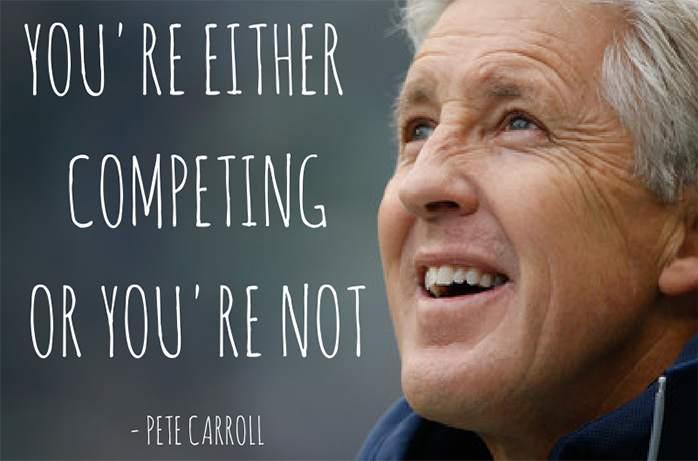
Donnan Hockey June Newsletter
If I could recommend one book that I think will help all who aspire to lead, whether it be as a leader in business, a coach, a teacher or a parent it would be Pete Carroll’s “Win Forever”.
After Pete Carroll was fired from the head coaching position of the New England Patriots, he knew he had to step back and look at his career from every possible angle. That’s when Pete found his philosophy. The “Win Forever, Always Compete” mantra was born.
Pete created the college football dynasty of the 2000’s at USC. The comments from many NFL experts when he left USC and was hired by the Seahawks, were filled with skepticism and doubt. Sure, Pete won at USC, but this is the NFL. Plenty of premier college coaches have flopped at the NFL level and many were expecting Pete to be another Nick Saban flop.
I am an admitted “Win Forever Junkie”, but I’m not just being a homer here, the more I’ve learned about Pete and the more I’ve had a chance to see the results of his philosophy and effort, the more I’ve bought into what Pete is selling. Not only have fans bought into what Pete preaches, but his players also seem to have a genuine belief in the philosophy and concepts that Pete is applying to the team.
Competition breeds success. But success can also be attained by the simple things. Confidence, trust, and focus are all parts of the Win Forever philosophy.
Another aspect of the WinForever campaign is the conscience reminder of the influence and impact of your words. During a WinForever seminar that I observed online, Pete was adamant that the impact of words and the use of those words, can have a monumental impact on the results you hope to achieve and the accomplishments you will achieve. I was fortunate to have a chance to watch this video and learned specifically how he deviates his words and the delivery of them in different moments.
“Well, hopefully through the process, the message is really consistent and the message encompasses all of the situations,” he replied. “Meaning, that you know we are going to go out and play like we are capable of playing. If we go out and we win and we play like that, then the message is okay – that’s exactly what we tried to get done. If we lose and play like we are capable of playing, then the message is we did everything we could, but they were better on this day. We can live with that. The message is really consistent.
“I may shock them that I’m not affected by the situation (a loss) like they would think. I may be, because I stay so tight to the message. That’s where philosophy is so powerful. They think “okay, alright, he does believe what he’s saying. He does believe what he’s all about. He does continue to emphasize the things he emphasizes when it was easy in the meeting room and it’s happening here in the locker room at half-time.” So there is a staging all the way through the process of thoughts that encompass the situation no matter what they are.
“Hopefully, I’ve done a good job, then I just remind them – “This is how we act now. This is what we expect now.” If you are responding to the moment and trying to figure it out, then you are going to screw it up. I’ve done that plenty of times.”
What to take from this answer?
Consistency. The consistency of the message is what’s important. If you believe and stand for certain principles and always maintain and uphold your philosophy, then the team will buy into the message.
Another thing he spoke about was confidence. How does he build a player that might be struggling or having a difficult time with confidence? How does he keep other players from becoming overconfident or too cocky?
“It’s so important for us, to figure each guy out – to find out where they are, who they are, so we have a sense,” said Carroll. “It’s about learning who they are, figuring out who the players are so that we have a sense to gauge that.
“Take Donny (Lisowski), for instance (an undrafted free agent who earned a contract with Seattle). He may not be very confident (Pete was being hypothetical), but he plays like he is. He’s a hell of a kid out there – and Doug Baldwin, he just screams confidence. He’s got a chip on his shoulder, and that’s huge, you know. He isn’t backing down from anyone or anybody and so those guys you just gotta stay out of their way a little bit. Other guys you have to build up. You can just sense by their body language, the way they speak, the way they take their opportunities and stuff, they need to be bolstered you know. That’s the guy you put your arms around and show them why you need to believe in yourself. It’s just a process that comes from interchanging analysis to figure them out. Once you figure them out, hopefully you can scope the message to them that helps them.”
Instilling confidence in a player is absolutely crucial. An athlete cannot perform at their maximum level without confidence in themselves. The belief of the coaching staff and teammates can also have a positive impact on performance. Take Richard Sherman, for example. He was so confident last year that he was talking trash to other players that were first round draft picks, the famous example being Cincinnati’s A.J. Green. Pete believed in Sherman enough to put him in the starting lineup as a rookie, and Sherman excelled and rewarded Pete’s trust.
A question Pete posed to the audience (many of which were current coaches) was, ‘how have coaches had an effect on you?’ ‘Have you had coaches that have had a negative or positive impact on you?’ Pete always tries to give off a positive presence and he tries to create a competitive, yet positive atmosphere where his players can compete to their utmost potential.
Pete clearly has established his own identity as a coach and he has found a permanent philosophy to always apply to the team. He has a consistent message and that message of “Win Forever – Always Compete” has had a positive impact on the entire Seahawks program. One of my personal favorite parts of the book was when he differentiated between practices and games. He was very clear in saying that his teams will practice harder than any other team. He expects practices to be more difficult than games. This allows the athlete the freedom to just go out and PLAY on game day. Below, is what he feels are his 5 greatest traits in leadership:
Enthusiasm and Love for the Game
Pete Carroll’s passion for the game of football is infectious. If you’ve ever seen an interview with Coach Carroll or watched him on the sidelines during a game, you can’t miss the fact that he loves what he does. He exudes energy and everyone around him (most importantly, members of his team) pick up on that energy and it becomes part of them – building their excitement and commitment to win. “He coaches with passion,” said Seahawks Linebacker and Special Teams Captain Heath Farwell. “And that’s why guys play hard for him.”
There’s a great deal of research and literature that shows us that student-athletes world respond similarly to leaders who are passionate and enthusiastic. One of the first steps that a leader can take to create a work environment where student-athletes feel engaged and look forward to coming to work is to embody their own commitment to, and passion for, the work and the mission. As Erika Andersen, author of Leading So People Will Follow asserts “real passion provides inspiration that’s much deeper than cheerleading or a temporary emotional high. When leaders are truly passionate, people feel included in the leader’s commitment, part of making important things happen. That’s satisfying on a very deep level, and it lasts.”
Player Development: He Embraces Teachable Moments
Carroll is widely known as a “players’ coach” and according to ESPN NFL Analyst Eric Allen “he really realizes that it is all about the players: players win and lose football games.”
While some view players’ coaches as being “soft on players” Team Captain Farwell believes that this perception isn’t true with Carroll. “Carroll is respected by players because of his clear teaching methods and his positive-reinforcement approach to coaching.”
“Players’ coaches give you tools that you can use to be successful – so that no matter where you are, you’re able to understand the game – you grow as a player – you grow as a person,” said Allen. They “prepare you and give you an opportunity to be a better player and then hold you accountable.”
In dealing with youth, leaders can become so focused on the results, and oftentimes on their own individual success and ambitions – that they don’t focus on the development and growth of the very people who they are supposed to be there for: the student athletes. This sort of neglect can often lead to youth feeling disengaged and demoralized – which then contributes to less than optimal performance and compromised commitment to the task – as well as less loyalty to their leader and to the process as a whole.
Leaders who focus on individual development and provide the tools, and support to be successful are also much more likely to have high performing teams – and athletes who will be there for them even through the most demanding and high stakes times – which becomes increasingly important as they progress through the stages of their sport.
He Corrects Player’s Mistakes – Immediately and Honestly
Carroll’s approach is to focus on letting players know how to do things “right” moving forward and not to put the focus on what went wrong.
“If you make a mistake, he uses that as a teachable moment,” said Farwell.
“Pete explains what you did wrong and how you can correct. If you do something wrong, he will say that’s not acceptable by the organization and explain why.”
In his recently published Love Letter to Coach Carroll, Seahawks Cornerback Richard Sherman notes that Carroll “finds the positives when we lose, in addition to the things we can improve on. I’ve never been on a team where the coaching staff was so positive. There isn’t a lot of yelling and cursing at players. There’s no talking down to players. It’s about conversations, not aggression.”
“We don’t feel like we benefit from that,” Carroll said. “We want to tell them the best thing we can tell them as quickly as we can. It isn’t necessary to scream at them or yell at them. There are other ways to do it.”
“The principle of it is we want to tell them, as soon as possible, exactly what they need to do to get it right,” said Carroll “It’s more about the correction than whatever the result was.”
“We all make mistakes, but with Pete, it’s about learning from it,” said Farwell. “He’s not a talk-down-to-you or yell-at-you kind of coach.”
“It’s something that I think I’ve always done naturally, in respect to the players,” Carroll said. “There are plenty of ways to adjust their play or be critical without doing it in the public eye.” And the players definitely seem to respond well to this approach.
There is a lot of evidence indicating that the most effective feedback is given in a timely fashion – so that the behavior stops and is corrected – and the student-athlete is empowered, as soon as possible, to understand how to proceed more effectively.
However, in a conflict averse culture, many leaders are loathe to provide “real time” feedback to their athletes and would prefer to wait until the annual (or bi-annual) appraisal review to share their concerns. While this may be well intentioned – and feel less confrontational – waiting to correct poor performance can be a disservice to the student-athlete and can be potentially damaging to the work that needs to get done.
Leaders can benefit greatly from Carroll’s timely approach to giving feedback – and should aspire to provide feedback as soon as there is a concern – redirecting the youth’s energies to an approach that will be more effective.
He Creates a Competitive and Challenging Work Culture
The results of the NFL Nation survey confirm that Carroll has created a dynamic and thriving work culture. He has set a tone that appeals to the most ambitious and competitive players. This attracts “guys who want to play and want a challenge” said Allen. “He talks about competition and practice.” According to Allen, the Seahawks team is now “one of the destinations around the league.”
Pete is also a huge fan of competition (recall his book Win Forever: Live, Work, and Play Like a Champion, published in 2011) – and while team camaraderie is essential – he still leaves room for the “cream to rise to the top” as we saw during the Seahawks 2012 training camp – with his “open quarterback competition” approach, when rookie Russell Wilson outplayed Tavaris Jackson and Matt Flynn to take the starting position.
While exhibiting lots of emotional intelligence and working so well to engage and inspire his team, Carroll’s eyes are also always on the prize. “We’re doing it with standards and expectations that are as high as you can get,” he said. “I’m glad we’ve found a way to do it that guys appreciate it.”
Creating a culture and environment that offers challenges and balances competitive opportunities with teamwork can provide huge rewards and satisfaction for both coaches and athletes – and can serve to be a “win-win” all around for all stakeholders. Engaged youth . . . are willingly to go the extra mile, train with passion, and feel a profound connection to the process. They are the people who will drive innovation and move the process forward.
Pete Carroll’s recipe for success in the NFL provides practical takeaways that many leaders and can learn from and implement. And, the “players” are sure to appreciate their efforts – making it more possible to attain the equivalent of getting to the “Super Bowl” in personal development.
Team Dynamics – He Encourages Players To Work Together; To Be Their Best And Have Fun Doing It
According to Farwell, Carroll makes playing the game fun, but it isn’t a party. The Seahawks worked very hard all season to get to the Super Bowl.
“We practice hard on every play and we work as hard as any team, or harder,” Farwell said. “But it’s a fun team to play on because Pete’s always so positive. He’s the biggest cheerleader on the sidelines.”
“I get texts from guys across the league, which remind me how good we’ve got it in Seattle,” said Sherman. “They ask, “Is he really as cool as he seems?” and “I hear you guys have fun at practice?” Sherman responds “Yes and yes.”
“Players work well as a team – they believe in each other . . . treated like a family,” said ESPN’s Allen. “Whenever you hear guys in the locker room it’s always about “us, us, us” . . . I understand why players want to play for . . . Pete.”
While psychology and human nature would suggest that leaders would routinely follow Carroll’s positive encouragement of supportive team dynamics, we all too often see quite the contrary in the youth sports world where some of our more traditional coaches and leaders are notoriously guilty of creating a “Hunger Games” type work environment in which each student is an “island unto themselves” – competing against one another to get ahead and to show that they have “the stuff” that will get them to their goals.
The most effective environments occur when each individual can do his or her best work (and be recognized and rewarded for it) while at the same time working with their peers to strive towards a collective end – where they all are rewarded for successes.
Over the summer take the time to purchase this book and try to implement the key philosophies into your student athletes development process.









